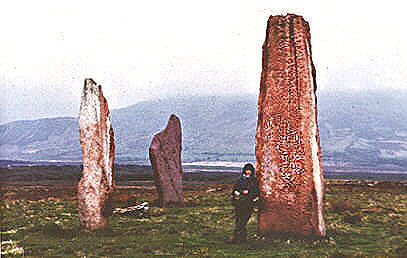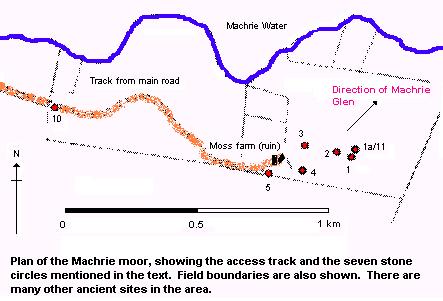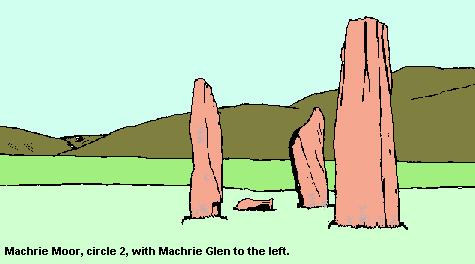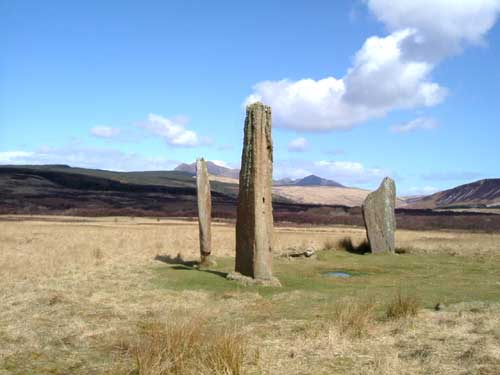
Machrie Moor, Arran - stone circles
Stones of Wonder
QUICK LINKS ...
HOME PAGE
INTRODUCTION
WATCHING
THE SUN, MOON AND STARS
THE
MONUMENTS
THE
PEOPLE AND THE SKY
BACKGROUND
ARCHAEOASTRONOMY
USING
THE SITE DESCRIPTION PAGES
VISITING
THE SITES
THE
LEY LINE MYSTERY
THE
SITES
ARGYLL
AND ARRAN
MID
AND SOUTH SCOTLAND
NORTH
AND NORTH-EAST SCOTLAND
WESTERN
ISLES AND MULL
Data
DATES
OF EQUINOXES AND SOLSTICES, 1997 to 2030 AD
DATES
OF MIDSUMMER AND MIDWINTER FULL MOONS, 1997 to 2030 AD
POSTSCRIPT
Individual
Site References
Bibliography
Links
to other relevant pages
Contact
me at : rpollock456@gmail.com
Stone Circles NR911324 - Location map

Machrie Moor, circle 2, with prehistoric human for scale
How to find: From the A841 on the west coast of Arran, 5km north of the village of Blackwaterfoot, a signposted track leads to the stones. A walk of 1.5km from the road is necessary. The track can be wet at any season. The circles are in state care.
Best time of year to visit: Summer solstice sunrise, about June 21st.
On Machrie moor is a complex of stone circles, standing stones, cairns and hut circles which makes it one of the most interesting and remarkable archaeological sites in Scotland. It is well worth the short walk to visit the site at any time of year.
Studies have shown that the circles are located in positions on the moor so that they can be seen from as wide an area as possible1, and any visitor will be struck by the beauty and atmosphere of the location. It is worth while remembering as you cross the boggy ground to the sites that the circles were erected in a period of much drier weather, before the growth of sphagnum moss and heather rendered the land unusable for cultivation. Two of the circles have recently been excavated2, and the amount of peat growth over the original prehistoric ground surface can be seen as a tidemark on the stones. Indeed one of the circles (number 11) had completely disappeared under the peat.
It cannot be assumed that the stone circles and standing stones on Machrie moor were all erected at the same time, and anyway the different layouts of the circles suggest this is not the case. From west to east as you approach (see plan) you will see - (circles are numbered by convention)

Circle 10 immediately right of the track, has a cairn within it.
Circle 5 which is a double circle, the inner ring being of 8 granite boulders and the outer of 15 boulders. A ruined cist was found in the centre of the circle in a 19th century excavation. The circle is known as Fingal's Cauldron Seat, the hero Fingal having tied his dog to the stone with a hole in the outer circle while he cooked a meal.
Circle 4 has four granite boulders remaining, and was probably only about 6m in diameter originally.
Circle 3 has one large stone still standing, and the stumps of three others still visible. Nineteenth cenury excavations revealed a central cist with a food vessel and some flint, and a second cist with a crouched burial.
Circle 2 is the most impressive of all, with three large and spectacular shaped sandstones still surviving in situ. In 1861 an excavation revealed two cists, one with a food vessel and flint flakes, the other empty. An attempt has been made to fashion a millstone from one of the fallen stones, then the work has been abandoned, with the stone still lying where it was left.


Another view of circle 2 on Machrie moor (courtesy Derek Hall, Perth)
Circle 1 is an ellipse of about 14.5m x 13m. You will notice how sandstone slabs and blocks of granite have been set alternately.
Circle 11 (also known as 1a) has been excavated together with circle 1 and is similar to it. The excavations, which took place in 1985 and 1986, demonstrated that the stone circles had been erected on the exact site of previous timber rings, with the land having been ploughed over in the interval.
It has been suggested by Barnatt and Pierpoint3 that circles 1,2 4 and 11 were sited for observation of the sun at midsummer, which at that time rises in the very prominent notch to the north-east formed by Machrie glen (the main route to the east side of the island). Within five minutes of the of the sun leaving the horizon, it would be visible from circles 3 and 5 also. Why so many circles are needed is not clear.
Barnatt and Pierpoint also state that from circle 3 and circle 5, the notch indicates the rising northern (winter) full moon at the minor standstill.
A prominent notch visible from circle 5 to the north-west also indicates the setting northern (winter) full moon at the time of the major standstill.
LauraRobertson.com sells paintings of the Machrie Moor stones.